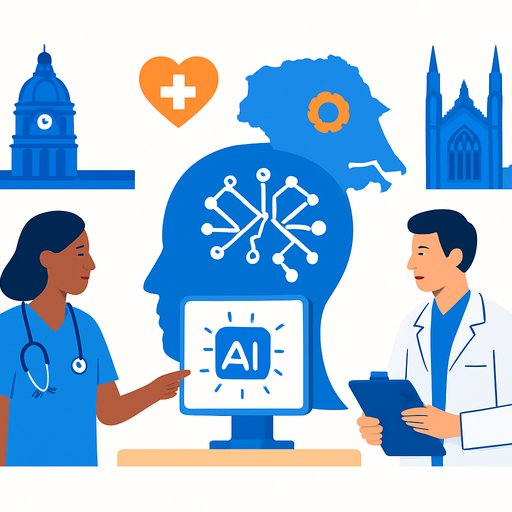AI in the NHS: from concept to clinic
Artificial intelligence is already part of daily practice across the NHS. It accelerates diagnosis, supports decision-making, and gives patients more control over their care.
Used responsibly, these tools can help address demand, cost pressures, and health inequalities. Yorkshire is well placed to set the pace for the rest of the country.
Why Yorkshire is well placed
The UK has joined a new global network of health regulators focused on safe, effective use of AI in care. That international collaboration matters for standards, safety, and public trust.
Leeds is the new digital hub for the Medicines and Healthcare products Regulatory Agency (MHRA). From here, regulators will work with global partners to set standards, monitor real-world safety, and share early warnings-practical steps that build confidence in clinical settings.
Leeds has also been selected as a thematic policy campus to lead the Government's Health Mission. The approach is simple: bring community insight and frontline expertise into policy development so technology solves the right problems.
Real pilots across the region
At the Jean Bishop Integrated Care Centre in Hull, voice technology is being trialled to reduce admin burden so staff can spend more time with patients.
In West Yorkshire, an AI-based test developed by PinPoint Data Science aims to identify cancers sooner and get patients to effective treatment faster.
What must go right
- High-quality data: Clear definitions, consistent coding, strong governance, and active bias monitoring.
- Regulation and assurance: Clinically led oversight, transparent model performance, and clear routes for incident reporting.
- Trust: Clinicians need clarity on how tools work and where they fail. Patients need to understand benefits, risks, and choices.
- Practical adoption: Integrations with existing workflows and EPRs. Minimal extra clicks. Obvious time savings.
- Equity and access: Design for people with low digital confidence; don't widen the gap.
- Evaluation: Measure outcomes, not pilots-time to diagnosis, avoidable admissions, patient experience, and safety signals.
The NHS shift AI can support
- Analogue to digital: Automate admin, triage, and documentation to release clinical time. Embed clinical safety checks.
- Hospital to community: Remote monitoring, risk stratification, and virtual wards that escalate only when needed.
- Sickness to prevention: Early detection, proactive recall, and personalised prompts that reduce avoidable harm.
Digital inclusion needs attention
Some people are at risk of being left behind as services move online. Support them with simple onboarding, plain language, SMS fallbacks, and in-person options where needed.
Encourage patients to use the NHS App for appointments, prescriptions, and records. It's a practical step that improves access without adding workload. NHS App
Practical steps for NHS leaders and clinicians
- Pick high-yield use cases: Documentation, imaging prioritisation, referral triage, waiting list validation, and early cancer detection.
- Data readiness: Map data flows, fix coding issues, agree data definitions, and set access controls before procurement.
- Clinical safety and governance: Appoint a CSO, define safe use cases, require model cards and validation evidence, and record decisions.
- Workflow first: Design with frontline teams. If it adds clicks, redesign it. Shadow mode before live.
- Procurement with outcomes: Contract on measurable results and interoperability, not features.
- Interoperability: Use open standards and APIs. Avoid vendor lock-in.
- Training and support: Offer short, role-based training and quick-reference guides. Provide a clear escalation path.
- Evaluate and iterate: Track clinical impact, equity effects, false positives/negatives, and unintended consequences.
- Communicate with patients: Explain how AI is used, what it means for care, and how to opt out where applicable.
- Report safety issues: Use existing clinical risk processes and feed learnings back to suppliers and regulators.
Measuring value
- Operational: Minutes saved per encounter, throughput, and reduced backlog.
- Clinical: Time to diagnosis, admission avoidance, improved guideline adherence.
- Equity: Uptake and outcomes by demographic group; targeted mitigation if gaps appear.
- Financial: Cost avoidance and return on investment within agreed timeframes.
- Workforce: Staff satisfaction and reduction in burnout drivers (documentation time, after-hours work).
- Safety: Incident rates, overrides, and calibration drift over time.
How Yorkshire can lead next
Bring universities, innovators, ICSs, and providers into a single pipeline: discovery, sandbox testing, evaluation, and rapid scale for what works. Publish performance openly to build trust.
Focus on a few shared platforms: documentation support across primary and community care, cancer triage across pathways, and integrated remote monitoring for long-term conditions. Scale across the region with common standards and shared learning.
Useful resources
Upskilling your team
If your organisation is building AI literacy for clinical, operational, or leadership roles, explore curated learning paths by job function. Courses by job | Latest AI courses
Bottom line: AI will help the NHS deliver earlier diagnosis, safer care, and better access-if we pair strong governance with real-world integration. Yorkshire has the network, talent, and momentum to prove what good looks like.
Your membership also unlocks:






